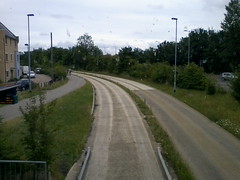 The Cambridgeshire Guided Busway has overtaken Adelaide's O-Bahn Busway as the world's longest. On Sunday I had a trip from Cambridge, to Huntingdon via St Ives. Most people in Cambridge may not even notice the bus-way, as in the city the specially adapted buses travel on ordinary roads and use ordinary stops.
The Cambridgeshire Guided Busway has overtaken Adelaide's O-Bahn Busway as the world's longest. On Sunday I had a trip from Cambridge, to Huntingdon via St Ives. Most people in Cambridge may not even notice the bus-way, as in the city the specially adapted buses travel on ordinary roads and use ordinary stops.If you look closely you will see small guide wheels (about the size of a small dinner plate) next to the front wheels of the buses. These contact the edges of the bus-way to steer the buses.
You board and pay for a ride like an ordinary bus (I took a double decker bus, with an excellent view from the front seats upstairs). One complication is that there are two separate companies provideing ser sercves and their tickets are not interchangeable: if you buy a return ticket from one company you cannot travel back on the other. You can use a smart card between both services, but these have to be ordered by mail and cannot be purchased on-lboard.
The bus-way starts just outside Cambridge, where the bus leaves the normal road, goes over a car trap (a pit in the center of the roadway to stop ordinary cars driving onto the bus-way)and onto the concrete tracks. The bus-way is mostly built like a concrete railway, with two wide concrete rails (one for each side of the bus) and a raised edge for the guide wheel. There is grass growing between the rails and between the two sets of tracks. The ride is quite bumpy as the bus goes over the joins in the track and also the bus sways from side to side (more so than I remember from the Adelaide bus-way). The swaying is likely more pronounced on the top deck of a double deck bus (Adelaide has had problems with swaying of the rear of articulated buses).
The bus-way follows a disused railway track and at times goes close behind houses, with a high sound barrier on each side (which you can see over from the top deck). Out in the countryside there are wetlands on either side, with people bird watching and fishing. At one point near St Ives there is a marina at the river.
There are several stops along the way with park and ride facilities and I noted one disused railway station. Between St Ives and Huntingdon the bus travels on ordinary roads. To get the guided bus-way experience you might as well just go Cambridge to St Ives and back.
In 2009 I traveled the 12 kilometers, of Adelaide's O-Bahn Busway which was then the world's longest. The experience in Cambridge is similar. This is not a glamorous mode of travel (like a monorail), but a pratical solution to a particualr problem: where space in confined or ground too soft or undevne for a normal roadway to be built.
The o-bhan bus guidance technology is a simple and proven mechanical system. However, technology has advanced to the point where it should be possible to achieve the same result using electronics. Using automatic lane and cruse control developed for cars and trucks, it should be possible to have buses self steer in bus lanes and keep a safe distance from each other. This should make it possible for buses with no mechanical modifications to travel on an o-bhan bus-way, as well as one on an ordinary roadway. Also it should be possible to use positioning technology and communications technology to safely share one lane for two way traffic. This would allow, for example, just one lane to be built and passing lanes at the bus-stops. Buses would take turns to use the lane, waiting at the stops (just as trains do on many lines now). This would greatly reduce the cost of the construction of bus-ways. At peak times buses could travel in convoys, with each automatically separated by a safe distance.
No comments:
Post a Comment